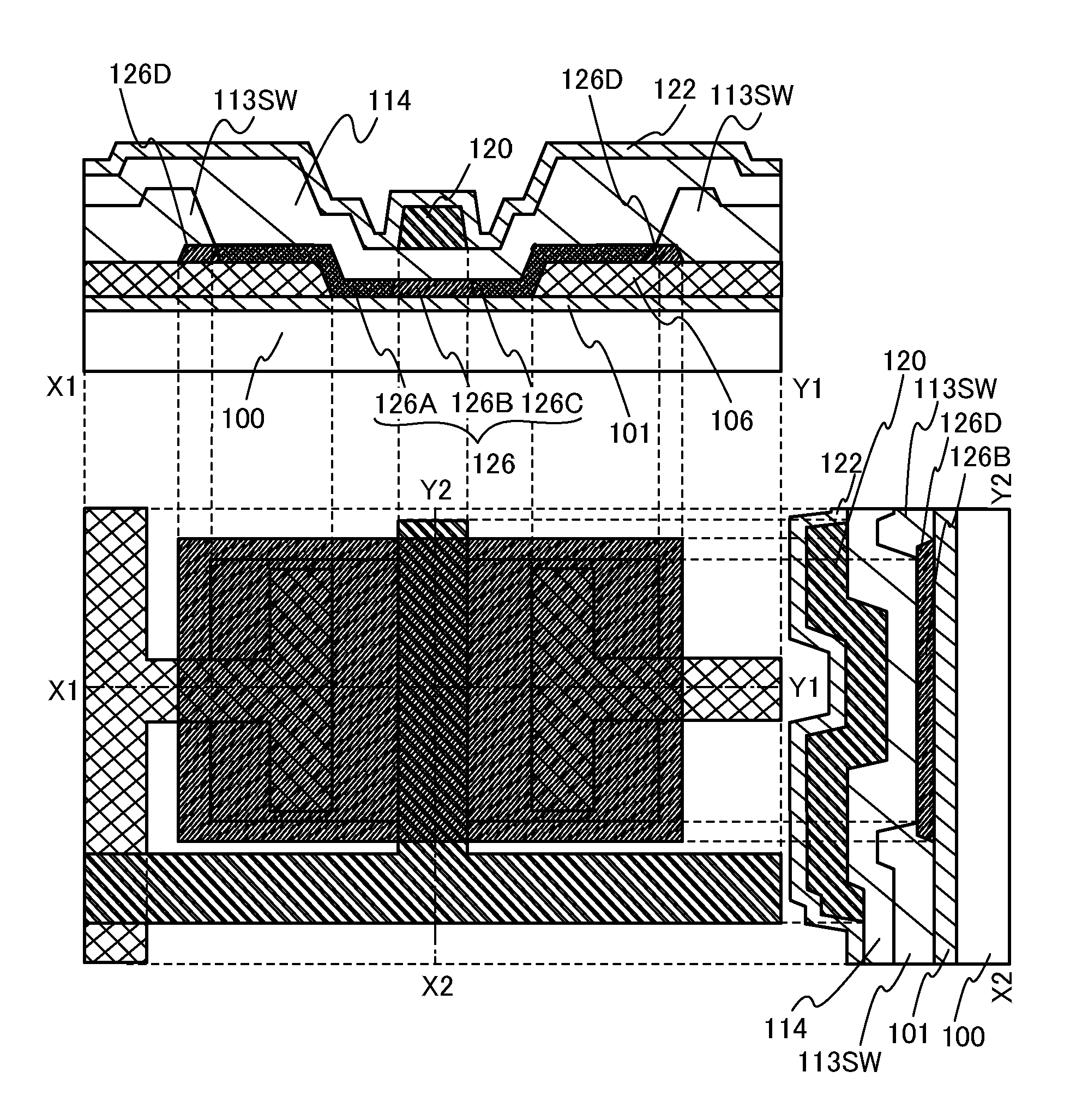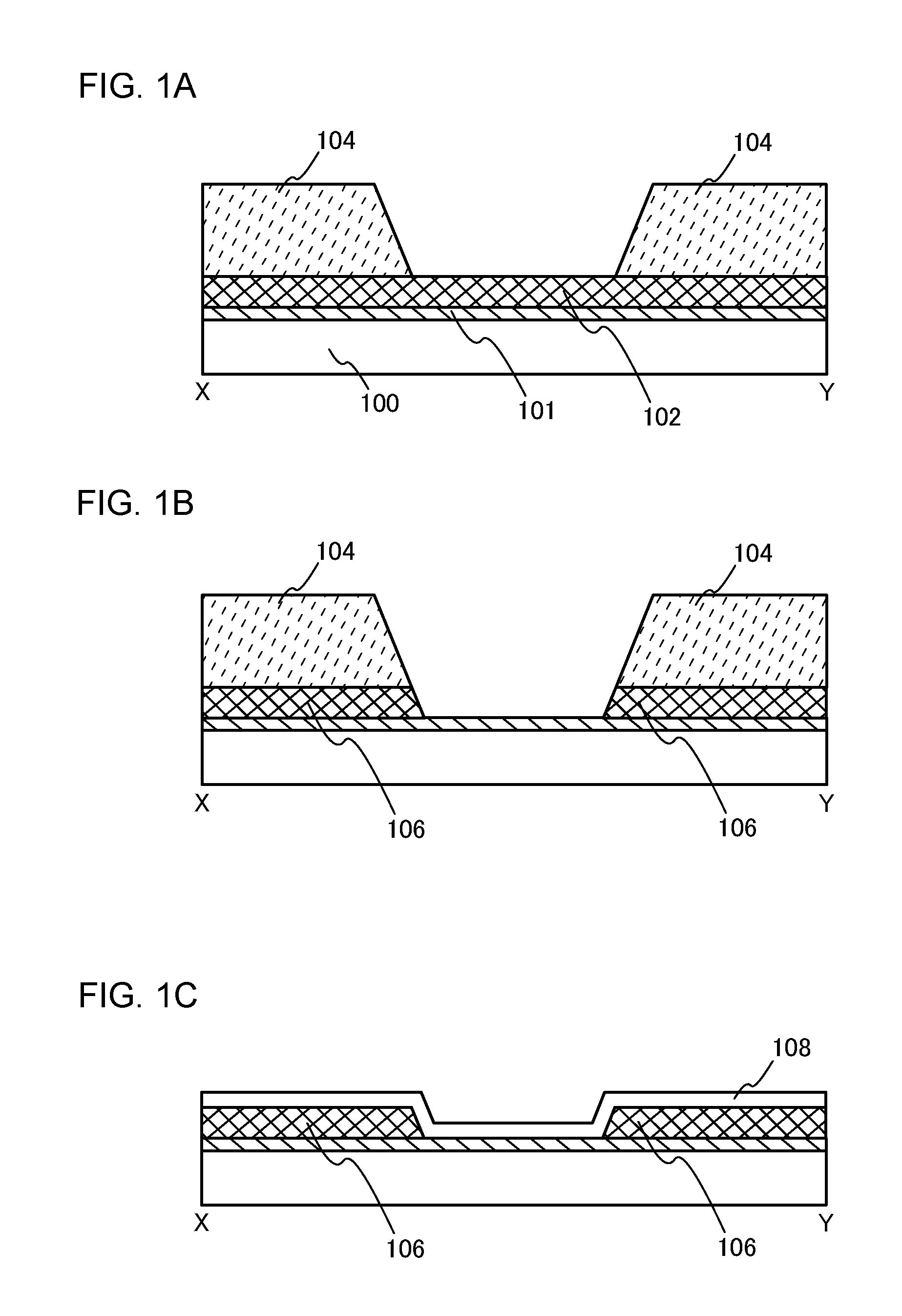Method for manufacturing semiconductor device
a semiconductor and manufacturing method technology, applied in the direction of semiconductor devices, basic electric elements, electrical appliances, etc., can solve the problems of oxygen deficiency, etc., and achieve the effect of reducing leakage current between a source and a drain and preventing deformation
- Summary
- Abstract
- Description
- Claims
- Application Information
AI Technical Summary
Benefits of technology
Problems solved by technology
Method used
Image
Examples
embodiment 1
[0038]In this embodiment, a method for manufacturing a semiconductor device which is one embodiment of the present invention is described. Specifically, a method for manufacturing a transistor is described.
[0039]A method for manufacturing a transistor of this embodiment is as follows: a base insulating layer 101 and a first conductive film 102 are formed over a substrate 100; a first etching mask 104 is formed over the first conductive film 102; a first conductive layer 106 is formed by processing the first conductive film 102 using the first etching mask 104; the first etching mask 104 is removed; a first oxide semiconductor film 108 is formed over the first conductive layer 106; a second oxide semiconductor film 109 is processed by performing at least first heat treatment on the substrate 100; a second etching mask 110 is formed over the second oxide semiconductor film 109; a first oxide semiconductor layer 112 is formed by processing the second oxide semiconductor film 109 using ...
embodiment 2
[0161]In this embodiment, an application example of the transistor described in Embodiment 1 will be described.
[0162]FIG. 7A illustrates an example of a circuit diagram of a memory element (hereinafter, denoted by a memory cell) included in a semiconductor device. The memory cell illustrated in FIG. 7A includes a transistor 200 in which a channel formation region is formed using a material other than an oxide semiconductor (e.g., silicon, germanium, silicon carbide, gallium arsenide, gallium nitride, an organic compound, or the like) and a transistor 202 in which a channel formation region is formed using an oxide semiconductor.
[0163]The transistor 202 in which the channel formation region is formed using an oxide semiconductor is manufactured by the method for manufacturing a semiconductor device of one embodiment of the present invention which is described in Embodiment 1.
[0164]As illustrated in FIG. 7A, a gate of the transistor 200 is electrically connected to one of a source and...
embodiment 3
[0192]In this embodiment, an application example of the transistor described in Embodiment 1, which is different from the example described in Embodiment 2, will be described.
[0193]In this embodiment, a memory cell including a capacitor and a semiconductor memory device will be described. A memory cell 300 illustrated in FIG. 9A includes a first wiring SL, a second wiring BL, a third wiring S1, a fourth wiring S2, a fifth wiring WL, a transistor 302 (a first transistor), a transistor 304 (a second transistor), and a capacitor 306. In the transistor 302, a channel formation region is formed using a material other than an oxide semiconductor, and in the transistor 304, a channel formation region is formed using an oxide semiconductor.
[0194]The transistor 304 in which the channel formation region is formed using an oxide semiconductor is manufactured by the method for manufacturing a semiconductor device of one embodiment of the present invention which is described in Embodiment 1.
[019...
PUM
 Login to View More
Login to View More Abstract
Description
Claims
Application Information
 Login to View More
Login to View More - R&D
- Intellectual Property
- Life Sciences
- Materials
- Tech Scout
- Unparalleled Data Quality
- Higher Quality Content
- 60% Fewer Hallucinations
Browse by: Latest US Patents, China's latest patents, Technical Efficacy Thesaurus, Application Domain, Technology Topic, Popular Technical Reports.
© 2025 PatSnap. All rights reserved.Legal|Privacy policy|Modern Slavery Act Transparency Statement|Sitemap|About US| Contact US: help@patsnap.com



